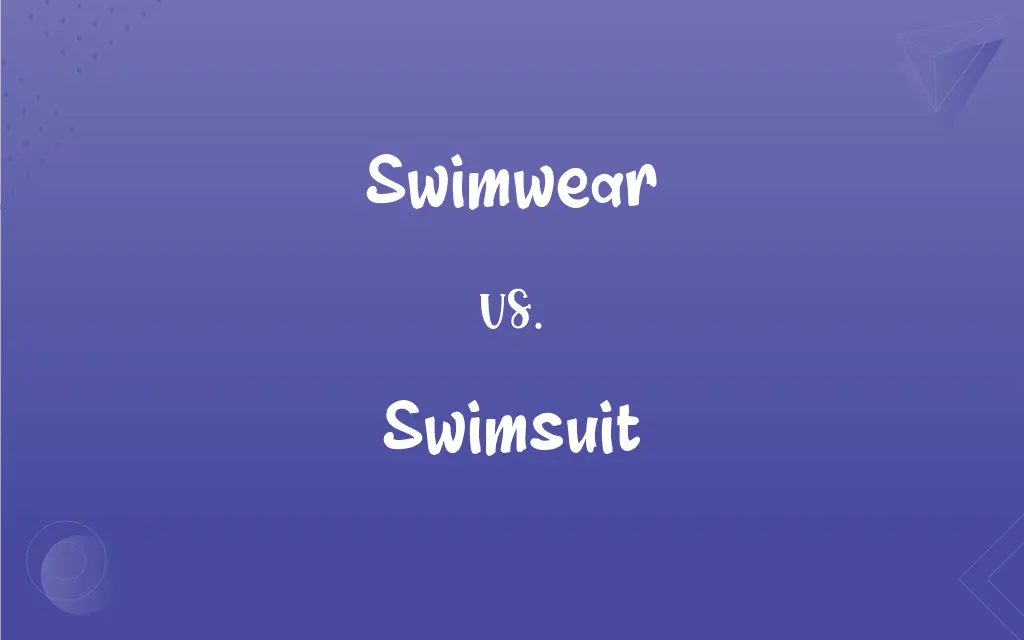Swimwear vs. Swimsuit: What's the Difference?
Edited by Aimie Carlson || By Harlon Moss || Updated on March 4, 2024
Swimwear refers to clothing designed for swimming and activities in water, encompassing a range of styles for all genders. A swimsuit, however, specifically denotes a one-piece garment for swimming, typically worn by women or girls.

Key Differences
Swimwear is a broad category that includes various types of garments designed for swimming or activities in and around water. This category covers a wide array of styles and pieces, such as bikinis, tankinis, one-piece swimsuits, trunks, and board shorts, catering to all genders and age groups. A swimsuit, on the other hand, is a more specific term within the swimwear category, typically referring to a one-piece garment worn by women or girls for swimming. Swimsuits are designed to provide a combination of functionality for swimming and aesthetic appeal. They come in various cuts and styles, offering different levels of coverage and support depending on the wearer's needs.
The distinction between swimwear and swimsuit lies in the scope of the terms. Swimwear serves as an umbrella term for all garments intended for water activities, encompassing a diverse range of products suitable for different preferences, body types, and activities. Swimsuits, as a subset of swimwear, specifically denote one-piece garments. The choice between different types of swimwear, including swimsuits, often depends on the individual's activity level, personal style, and the degree of coverage desired.
While both swimwear and swimsuits are designed for use in water, their selection is influenced by the occasion, such as leisurely beach days, pool parties, or competitive swimming events. Innovations in fabric technology have led to the development of swimwear that is not only stylish but also functional, offering features like UV protection, quick-drying materials, and resistance to chlorine damage.
All swimsuits are considered swimwear, not all swimwear is a swimsuit. The diversity within swimwear caters to a wide range of activities, preferences, and body types, reflecting the varied ways people engage with water-based activities.
Comparison Chart
Definition
Clothing designed for swimming and water activities, for all genders.
A one-piece garment for swimming, typically for women.
ADVERTISEMENT
Types
Includes bikinis, one-piece swimsuits, trunks, board shorts, etc.
Primarily one-piece designs.
Gender
For all genders.
Mainly for women and girls, but can refer to men's in broader use.
Purpose
Varies from recreational to competitive swimming, sunbathing, and water sports.
Focused on swimming but also considers aesthetic appeal.
Material
Made from materials like polyester, nylon, and spandex for durability and quick drying.
Similar materials, emphasizing comfort and performance in water.
Selection Criteria
Based on activity type, comfort, style, and coverage preference.
Often chosen for fit, support, and style within one-piece designs.
ADVERTISEMENT
Swimwear and Swimsuit Definitions
Swimwear
Encompasses a variety of styles.
The new swimwear line includes bikinis. tankinis. and rash guards.
Swimsuit
A one-piece garment for swimming.
She wore a floral swimsuit to the pool party.
Swimwear
Often chosen for specific water activities.
Competitive swimwear is designed to reduce drag.
Swimsuit
Can be used broadly for swimming garments.
His swimsuit is specially designed for triathlons.
Swimwear
Clothing designed for activities in water.
He chose lightweight swim trunks from the swimwear section.
Swimsuit
Typically designed for women.
The swimsuit collection features a variety of cuts and colors.
Swimwear
Suitable for all genders.
Swimwear for children comes in fun patterns and protective materials.
Swimsuit
Offers different levels of coverage.
High-neck swimsuits are popular for those seeking more coverage.
Swimwear
Reflects personal style and comfort.
She prefers high-waisted swimwear for added confidence at the beach.
Swimsuit
Balances function with fashion.
Her swimsuit provided both support for swimming and stylish details.
Swimwear
Clothing designed to be worn for swimming or with swimsuits.
Swimsuit
A garment worn while swimming.
Swimwear
Items of clothing appropriate for swimming
Swimsuit
A garment worn for swimming.
Put on your swimsuit and let's go for a swim.
Swimsuit
A tight-fitting one-piece garment worn by women and girls.
Jade refused to go swimming with her brother until he helped her find her favorite swimsuit.
Swimsuit
Tight fitting garment worn for swimming
FAQs
How has swimwear evolved over time?
Swimwear has evolved significantly, from heavy, restrictive garments to modern, lightweight designs that balance aesthetics with functionality, reflecting changes in fashion, materials technology, and attitudes towards swimming and body image.
How do I choose the right swimwear?
Choosing the right swimwear depends on your activity, personal style, comfort, and desired level of coverage. Consider the garment's material, design, and functionality for your specific needs.
Are swimsuits only for swimming?
While swimsuits are designed primarily for swimming, they are also popular for sunbathing and as fashion statements at pool parties and beaches, offering versatility beyond swimming.
Can men wear swimsuits?
While the term "swimsuit" traditionally refers to women's one-piece garments, in a broader sense, it can also loosely apply to men's swimwear, though terms like "swim trunks" or "board shorts" are more commonly used for men.
What's the difference between a bikini and a swimsuit?
A bikini is a two-piece swimwear option offering less coverage, while a swimsuit generally refers to a one-piece garment, offering more coverage and often designed for women.
What are some common features of competitive swimwear?
Competitive swimwear often features high-performance materials, streamlined designs to reduce drag, and compression elements to enhance muscle efficiency and reduce fatigue.
Why is swimwear material important?
Swimwear material is crucial for durability, comfort, and performance in water. Materials like polyester, nylon, and spandex offer benefits like quick drying, UV protection, and stretch for a good fit.
How can I care for my swimwear to prolong its life?
Care for your swimwear by rinsing it in cold water after use, washing it with a gentle detergent, avoiding the dryer, and laying it flat to dry away from direct sunlight.
How often should I replace my swimwear?
Replace your swimwear when it starts to stretch out, fade, or fray, which can vary based on usage, care, and quality. Proper care can extend the life of your swimwear.
Is it necessary to have different swimwear for various activities?
While not strictly necessary, having different swimwear for various activities (e.g., competitive swimming vs. beach lounging) can enhance comfort, performance, and durability.
How do I find swimwear that fits my body type?
Look for swimwear styles that complement your body shape, offer the desired level of support and coverage, and make you feel comfortable and confident. Trying on different styles and consulting size guides can help find the best fit.
Are there any swimwear trends I should be aware of?
Swimwear trends can vary widely, including high-waisted bikinis, sustainable materials, bold prints, and retro styles. Keeping an eye on fashion publications and swimwear brands can keep you updated on current trends.
Can swimwear be environmentally friendly?
Yes, many brands now offer eco-friendly swimwear made from sustainable materials, such as recycled nylon and polyester, to reduce environmental impact.
What is the difference between water-resistant and quick-drying swimwear?
Water-resistant swimwear is treated to repel water, helping you stay dry when you're out of the water, while quick-drying swimwear absorbs water but dries rapidly to prevent discomfort and reduce drying time.
How should I store my swimwear when not in use?
Store your swimwear in a cool, dry place, away from direct sunlight or heat sources. Ensure it is completely dry before storage to prevent mildew and fabric damage.
What should I consider when buying swimwear for children?
When buying swimwear for children, consider factors such as UV protection, comfort, ease of movement, durability, and the child's preferences for style and color. Safety features like flotation devices can also be important for younger children.
Is it acceptable to wear swimwear as part of a casual outfit?
While traditionally meant for water activities, fashion trends have seen swimwear, particularly stylish one-pieces and bikinis, being incorporated into casual and streetwear outfits, often layered with other garments.
Can swimwear provide UV protection?
Yes, many swimwear options now come with UPF (Ultraviolet Protection Factor) ratings, offering varying degrees of UV protection to help shield skin from the harmful effects of sun exposure.
How has the inclusivity of swimwear designs changed in recent years?
Swimwear designs have become more inclusive, offering a wider range of sizes, styles that cater to different body types and personal preferences, and designs that accommodate various physical needs and activities.
How can I ensure my swimwear lasts through the season?
To ensure your swimwear lasts, follow care instructions closely, avoid rough surfaces that can snag fabric, rotate between multiple pieces to reduce wear, and avoid storing wet swimwear in airtight bags to prevent damage.
About Author
Written by
Harlon MossHarlon is a seasoned quality moderator and accomplished content writer for Difference Wiki. An alumnus of the prestigious University of California, he earned his degree in Computer Science. Leveraging his academic background, Harlon brings a meticulous and informed perspective to his work, ensuring content accuracy and excellence.
Edited by
Aimie CarlsonAimie Carlson, holding a master's degree in English literature, is a fervent English language enthusiast. She lends her writing talents to Difference Wiki, a prominent website that specializes in comparisons, offering readers insightful analyses that both captivate and inform.
































































